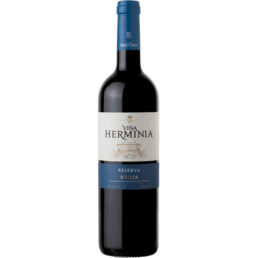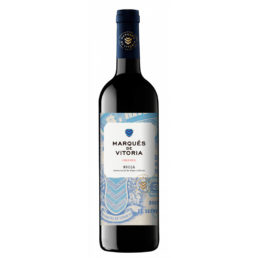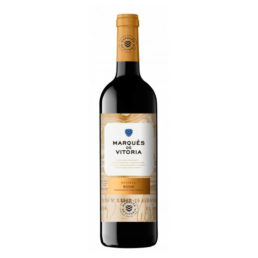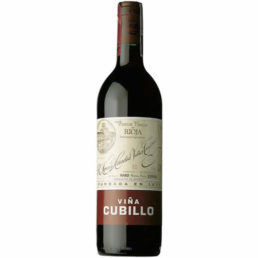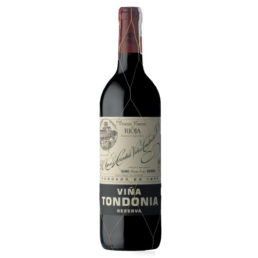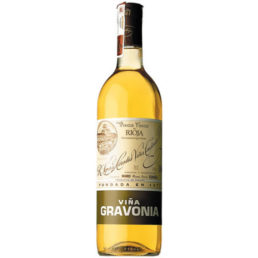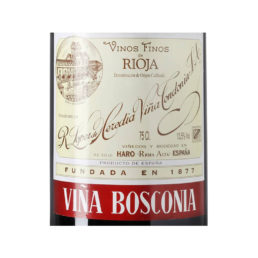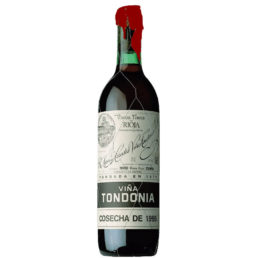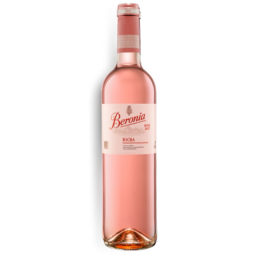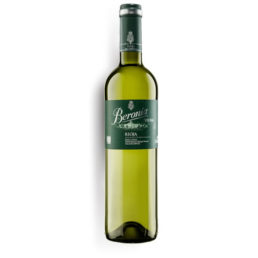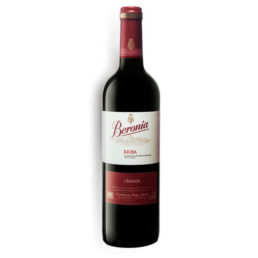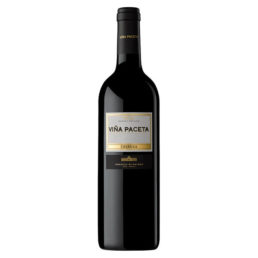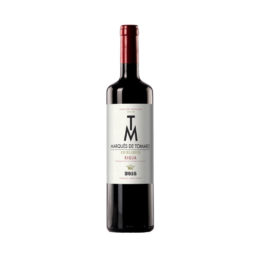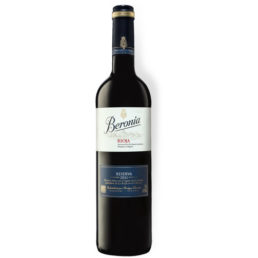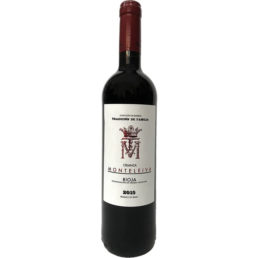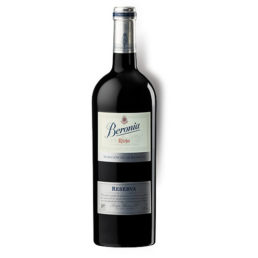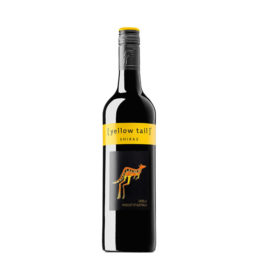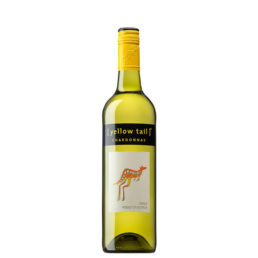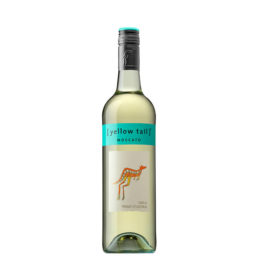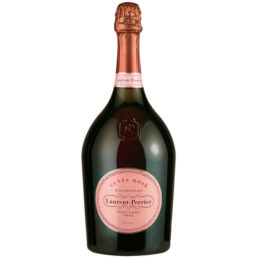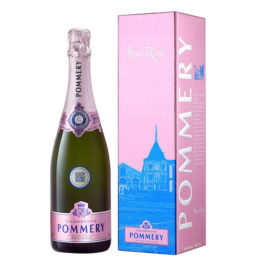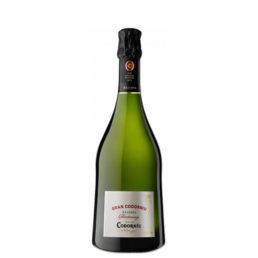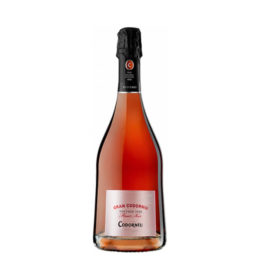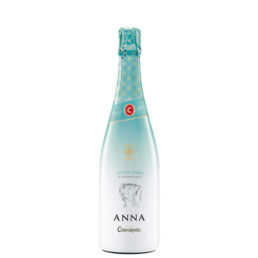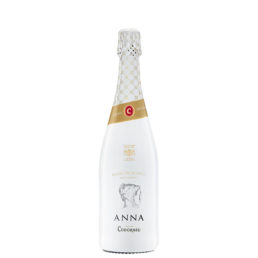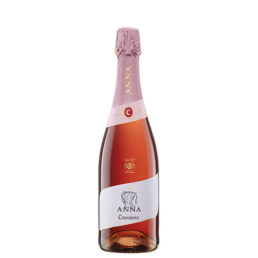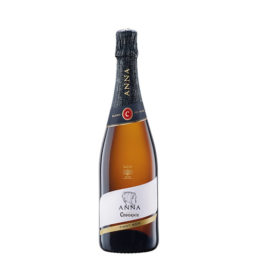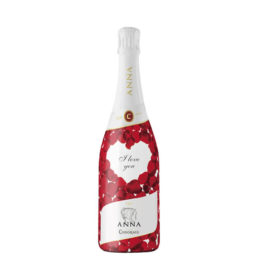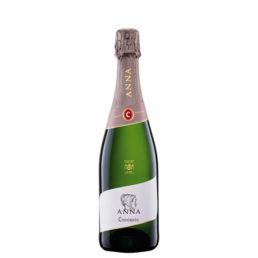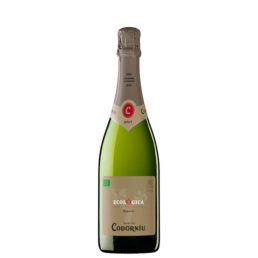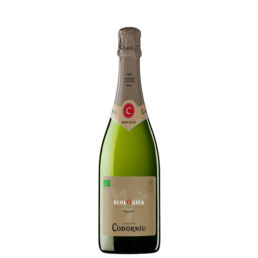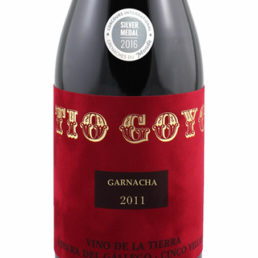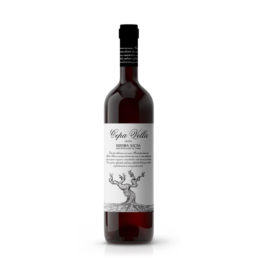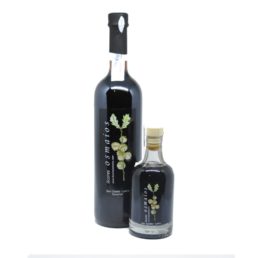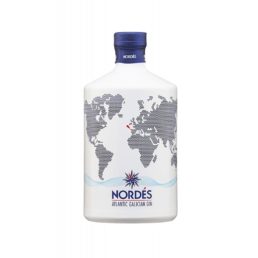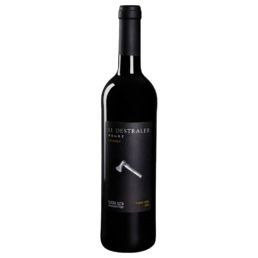2024
-
Viña Herminia Excelsus 2012
Made from Tempranillo and Garnacha. Intense and fruity, elegant and balanced, combines fruity notes and mineral, with the classic touch of the best Rioja, with length and persistence. Your parenting 8 months in French oak barrels, consolidating its aroma and its structure obtaining nuances clearly differentiating.PairingA wine ideal to accompany red meats, cheeses or game dishes less, surprise with dark chocolate. -
Viña Herminia Reserva 2010
The personality of this wine is marked by the richness of the Tempranillo, the force of the Grenache and the exuberance of the Graciano. A wine that is frank and very complex, with aromas of ripe black fruit, notes creamy and fund tobacco. Round in the mouth and very broad. A wine with a great aging potential.PairingThe perfect companion to roasts, stews, game and red meats. -
Red wine Marqués de Vitoria – Ecco Marques de Vitoria
The Group cellarmaster Faustino joins the trend of organic agriculture with the launch of Marqués de Vitoria ECCO. Elaborated with grapes of the variety tempranillo, from the vineyards of Sansol and la Cañadilla, the Marqués de Vitoria ECCO has been soaked during 12 days. A "wine of elegant character, fresh and soft", as described by the winery itself in the launch.PairingGrilled meats or grilled (steak, magret of duck), pheasant roasted with grapes, fatty cheeses (brie, cammenbert). -
Marqués de Vitoria Crianza 2014
Production/winemakingThe grape is harvested, selected, destemmed and fermented at controlled temperature in order to subsequently raise during 12 months in american oak barrels. Fine-tuned end in the bottle in the interior of the cellars.PairingIt is easy to pair with any type of meat. Grilled mushrooms. Some fish a lot of flavor or fatty, like tuna or cod. Cheese emmental or gruyere. Good with rice with mushrooms. -
Marqués de Vitoria Crianza 2015 (Magnum)
Production/winemakingThe grape is harvested, selected, destemmed and fermented at controlled temperature in order to subsequently raise during 12 months in american oak barrels. Fine-tuned end in the bottle in the interior of the cellars.PairingIt is easy to pair with any type of meat. Grilled mushrooms. Some fish a lot of flavor or fatty, like tuna or cod. Cheese emmental or gruyere. Good with rice with mushrooms. -
Marqués de Vitoria Reserve 2011
From of strains between 25 and 30 years of age. Remains 24 months in new French oak barrels followed by an ageing in bottle before release onto the market.PairingIt is easy to pair with any kind of meat and grilled mushrooms. Some fish a lot of flavor or fatty, like tuna or cod. Cheeses of medium healing; emmental and gruyere. Pasta with tomato and/or cheese.AwardsGolden Bacchus, Awards Bacchus 2016 (Spain)Gold Medal, World of Wine 2016 (Germany) -
Viña Cubillo Crianza 2012
HarvestThe grape harvest began on the day 6 October in "Vineyard Zaconia" with the white grape varieties, the day 9 October in "The Viña Tondonia Estate" with red varieties and finalized the 30 October after harvest "Viña Cubillas" and "Viña Bosconia".AgingAging in barrels during 3 years, subject to 2 fillings per year.BottledClarified with egg whites. Bottled unfiltered.Production93.000 bottlesPairingIt is the perfect companion for all kinds of legumes, tapas and hors d'oeuvres varied. -
The Viña Tondonia Estate Reserve 2002
Viña Tondonia Reserva wine 2002 Red 75 Cl. RiojaThe Tondonia Tinto is a fine wine, elegant with spicy and vanilla notes from barrel aging, without realizing it the whole bottle runs out, very easy to drink, accompanies both warm salads with quail or bird, puff pastry, foie gras with a reduction of raspberry jam, as to roast lamb, or suckling pig. In general, with almost everything, it is a wine that is very versatile. -
The Viña Tondonia Estate Reserve 2005 (Magnum)
Characteristics of the harvest: Year rated as EXCELLENT. Of the 170 has. in the property of our warehouse, distributed in our 4 farms, in this year 2005 we had 154 has in production. The harvest of 2005 was significantly lower than that of 2004, mainly because the sample of inflorescences in the bud break was a bit lower. The vegetative cycle occurred properly, in good weather conditions with absence of frost, and accidents meteorological remarkable, and only it should be noted that the advancement, about ten days, with the onset of the sprouting continued until the harvest which began the day 24 September in “Viña Gravonia” with the white varieties, the day 27 the same month, in “Viña tondonia estate” for the varieties and ended the day 22 October in “Viña Cubillas”. A strong storm surprised us on the day 12 October and produced this delay with respect to what might determine a start so early. In addition to this delay, so intense rainfall –more than 40 l/m2 in less than an hour– caused damage more important on the ground (drag land, fall of ribazos, flooding of farms and cellars...) in the bunches that were left for harvest, approximately a 20% of the final production, which we could qualify as a very good quality. The grapes came in healthy, with an average grade balanced and good concentration of colouring matter, essential characteristics to create wines with vocation for ageing.Aging in barrel: 6 years old, subject to 2 rackings per year. Clarified with whites of fresh eggs.Production: 250.000 bottles.Pairing: With notes of spices and vanilla from the barrel aging, without realizing the whole bottle just, very easy to drink, accompanies both warm salads with quail or bird, puff pastry, foie gras with a reduction of raspberry jam, as to roast lamb, or suckling pig. In general, with almost everything, it is a wine that is very versatile. -
Viña Gravonia Crianza 2012
Characteristics of the harvest: Year officially qualified as VERY GOOD. Year that goes by without incidents of weather severe, in the absence of spring frosts, but marked by abundant spring rainfall and post-harvest, however a summer of benign and drier favored the ripening and health of the grapes which resulted in the obtaining of a harvest it is not very abundant but of similar quality to that of the previous year. The weather was exceptionally favourable during the whole of the final phase of the vegetative cycle, something that is always decisive for the quality of the harvest. Our vineyards enjoyed optimal conditions for the health status of the fruit was virtually perfect, and the maturity to evolve with parameters, balanced color, acidity, alcoholic strength, etc., what that has allowed us to obtain a harvest of high quality and something lower on your final volume to the previous. The work of collection of the grapes began on the day 6 October in “Viña Gravonia” with the white grape varieties, the day 9 October in “Viña tondonia estate” with the varieties and finalized the 30 October after harvest “Viña Cubillas” and “Viña Bosconia”.Aging in barrel: 4 years old, subject to 2 rackings per year. Clarified with whites of fresh eggs.Limited production: 13.000 bottles.Pairing: cooked fish, fried or grilled, spicy. Seafood cooked a la plancha. White meats with sauces consistent. Combines well with pasta. -
Red wine – Viña Bosconia Reserva 2009
Add characterized by the absence of spring frosts, and the good environmental conditions that were conducive to the fertilization and the ripening of the grapes. All of this resulted in an abundant harvest despite suffering a summer unsettled and stormy that was balanced with the optimal climatic conditions of a month of October, bright and fresh. The harvest took place step-by-step with the perfect sanitary state of the grapes.AgingIs subjected to aging in oak barrels 5 years old, with 2 rackings per year.BottledClarified with whites of fresh eggs. Bottled unfiltered.PairingCured meats, legumes and stews, red meats and fighters, but also just a wonderful meal with cheese or chocolate desserts and wild black fruit. -
The Viña Tondonia Estate Gran Reserva 2001 Red
Aging in oak barrels: 10 years old, with 2 rackings per year, hand-made. Clarified with whites of fresh eggs.Pairing Meats and fish grilled, without strong spices. Also as a dessert wine accompanied by tubes filled with a fine pastry cream. -
Rosé wine Beronia – Beronia Rosé
VINIFICATION AND AGEINGBeronia Rosado performs a cold maceration of must in contact with skins, getting to extract the primary aromas from the Grenache and a subsequent alcoholic fermentation for fifteen days.PAIRINGIdeal to accompany salads, rice and pasta and white fish in all their different elaborations, as well as white meat and little fat. -
Vino blanco Beronia Blanco Viura
VINIFICATION AND AGEING Wine with a strong personality due to its production. Cold maceration of must in contact with the skins getting to extract the primary aromas from the variety.PAIRING Ideal to accompany salads and white fish in all their different elaborations, as well as white meat and little fat. -
Red wine Beronia Crianza 25 cl.
VINIFICATION AND AGEING After a slow Alcoholic fermentation, performs malolactic fermentation, and remains 12 months deposits. Subsequently this wine was transferred to barrels mixed: staves of american oak and funds of French oak, where it remains a minimum of 12 months. This is followed by a time in bottle before release onto the market.PAIRING It is the ideal companion for pasta dishes, vegetables and meats. -
Red wine Beronia – Beronia 3/8 Foster 2015
VINIFICATION AND AGEING After a slow Alcoholic fermentation, performs malolactic fermentation, and remains 12 months deposits. Subsequently this wine was transferred to barrels mixed: staves of american oak and funds of French oak, where it remains a minimum of 12 months. This is followed by a time in bottle before release onto the market.PAIRING It is the ideal companion for pasta dishes, vegetables and meats. -
Red wine Beronia Crianza
VINIFICATION AND AGEING After a slow Alcoholic fermentation, performs malolactic fermentation, and remains 12 months deposits. Subsequently this wine was transferred to barrels mixed: staves of american oak and funds of French oak, where it remains a minimum of 12 months. This is followed by a time in bottle before release onto the market.PAIRING It is ideal to accompany roasts, chops grilled, sausage iberian, or cured cheeses. -
Red wine Beronia – Beronia Crianza 2014 (Magnum)
VINIFICATION AND AGEING After a slow Alcoholic fermentation, performs malolactic fermentation, and remains 12 months deposits. Subsequently this wine was transferred to barrels mixed: staves of american oak and funds of French oak, where it remains a minimum of 12 months. This is followed by a time in bottle before release onto the market.PAIRING It is ideal to accompany roasts, chops grilled, sausage iberian, or cured cheeses. -
Red wine – Viña Paceta
Viña Paceta it is a red wine crianza from the O.D.. Rioja prepared by Bodegas Bilbaínas. It is a single variety of Tempranillo, grape par excellence of the region Rioja.The grapes to form Viña Paceta it comes from an iconic estate nestled in Halo, municipality known for the high density of wineries that you have and the quality of the same.Viña Paceta is formed from the de-stemming of the grapes, that makes a maceration of fifteen days subsequently. The wine ages eventually during 12 months in american oak barrels. -
Red wine Marqués de Tomares Excellence
Collection: Manual harvest with baskets.Elaboration: 55% carbonic maceration and 45% grapes destemmed. Maceration for 19 days with 3 stirred daily.Foster: 3 months in new barrel of american oak and 9 months in bottle.Recommended: It combines perfectly with cheeses, meats soft and blue fish. -
Red wine Beronia Reserva 2013
VINIFICATION AND AGEING This wine is made from a selection of the best grapes from vineyards older Tempranillo, Graciano and Mazuelo. After a slow and careful controlled fermentation with pumping over newspapers to extract the color and aromas are desired, this wine remained for 20 months in barrels mixed French and american oak, getting an evolution slow and harmonic. Later, he completed his parenting during 16 months in bottle before going to market.PAIRING Perfect to accompany with roasted, chops grilled, Spanish sausage iberico, or cured cheeses. -
Red wine Marqués de Tomares – Monteleiva Crianz
PairingVeal, lamb, milk-fed veal, poultry. -
Red wine Beronia 198 Barrels 2008 (Reservation)
VINIFICATION AND AGEING Selection of grapes from vineyards with an age of more than 60 years old. This wine is aged in a selection of the best new barrels and mixed, during 24 months. Subsequently complete their rearing for two years in the bottle, achieving their perfect balance.PAIRING This wine pairs perfectly with the cuisine, as the traditional cuisine. -
Vino tinto Beronia Gran Reserva 2009
VINIFICATION AND AGEING After a careful selection and fermentation of the grape, it has been aging for a 27 months in French oak barrels, By racking semester we get an evolution slow and orderly processes of their characters. Remains 36 months in bottle before going to market.PAIRING Ideal accompaniment of red meats, roast beef, cheeses and chocolate desserts. -
Red wine Beronia – III.C. Beronia 2008
DEVELOPMENTIt is part of the selection from vineyards of more than 70 years old, in addition the use of our vineyards prefiloxéricos. Cold pre-fermentation maceration for a few days, alcoholic fermentation below 26 ° C with pumping over newspapers. Ageing in new barrels of French oak during 14 months.AWARDS 91 points 2012 Parker (The Wine Advocate)SERVICE AND FOOD PAIRINGPerfect with red meats such as t-bone steak, steak, fillet steak or mature cheeses of sheep. -
Vino Tinto Yellow Tail Syrah – Australia
The philosophy behind the brand Yellow Tail is to offer wines that are simple and aimed at anyone who wants to enjoy a glass of wine with friends without major complications. Shiraz is the variety most widespread in Australia, so this wine red wine is the maximum expression of Yellow Tail. Yellow Tail Shiraz is a wine that is intense without being excessive, very easy to drink even as young wine.DEVELOPMENT (VINIFICATION) The Shiraz from Yellow Tail is made from grapes from vineyards of the highest quality. Once pressed and being removed from their stems, the grapes are fermented with the skins and in contact with oak wood. Its temperature-controlled fermentation ensures extraction of all the flavor, the color and tannins typical of the variety. The wine is bottled in the cellars of the family Casella, in Yenda, New South Wales.PAIRINGAccompanying Yellow Tail Shiraz with a good steak or a bbq. -
Vino Blanco Yellow Tail Chardonnay
The philosophy behind the brand Yellow Tail is to offer wines simple oriented to those who wish to enjoy a glass of wine with friends without major complications. Yellow Tail Chardonnay it is a white wine and fresh style lightweight, agrafeasible, refreshing, perfect to eat between friends or to celebrate the small joys of life.This wine is for sale in 40 countries -occur 100 millions of liters of wine per year- it has become the fourth wine brand most important of the world and the second most sold in the united States.DEVELOPMENT (VINIFICATION) Yellow Tail Chardonnay is made with grapes from vineyards of the highest quality. The fruit is pressed gently to extract the maximum freshness and flavor. The fresh grape clarified is fermented using a selection of different yeast strains. This adds complexity and texture to the wine end. The maturation of the lees of yeast, the malolactic fermentation and oak is used to impart creamy flavors of nougat, add richness and balance the acidity.PAIRINGIdeal to accompany seafood dishes, fish, or desserts. -
Vino Blanco Yellow Tail Moscato
Yellow Tail Moscato this is a white wine vibrant, full of flavor and personality. Yellow Tail Moscato is made with grapes from the best vineyards. The fruit is harvested in the cool of the night, to retain the maximum freshness and flavor. Para to ensure the smoothness on the palate, is used the must flower with a light pressed. The wine was stabilized and filtered cold to preserve all of its aromas.DEVELOPMENT (VINIFICATION)The Moscato Yellow Tail is made from grapes from vineyards of the highest quality. The fruit is harvested in the cool of night to retain maximum freshness and flavor. The must is obtained by leaving it out and applying slight pressure to ensure maximum softness in the mouth. Once developed, the wine is stabilized and filtered in cold to maintain their rich aromas and their freshness. Then assembled and added to a concentrated juice of grape to reduce their alcohol content.PAIRINGEnjoy Yellow Tail Moscato well chilled, as aperitif and with salad in summer. -
Champagne Laurent Perrier -Cuvée Rosé
The Cuvée Rosé it was created in 1968 from the boldness and the know-how of the House of Laurent-Perrier. Perfected at each stage of its manufacture, Cuvée Rosé is known for its consistency and its high quality. It is characterized by its aromas of ripe red fruit, high intensity and great freshness.Mix and wine making Varietal grape: Pinot Noir 100%Crus: 10 crus different mainly located in the areas south and north of the Montagne de Reims, including the famous Côte de Bouzy, especially of the best crus of Ambonnay, Bouzy, Louvois and Tours-sur-Marne .The grapes of plots in carefully selected classified and despalean before them. The maceration, lasting from 48h to 72h depending on the harvest, helps the extraction of colour and the development of the richness of aromatic full of Pinot Noir.Aging: 5 years minimum.The bottle Cuvée Rosé Laurent-Perrier, with their lines of generous and curvaceous, it is unique: an invitation to complacency. When Bernard de Nonancourt launched Cuvée Rosé Laurent-Perrier in 1968, he decided to present his creation in a bottle uniquely distinctive to magnify this cuvee a very special.He found his inspiration in the bottle quite thick made in the time of King Henry IV, adding the shield-shaped monogram "LP" with the form of seal. The packaging, in that moment it seemed very modern, has evolved gradually from 1968.In these days, Cuvée Rosé Laurent-Perrier is sold in a case of presentation is extremely elegant, reminiscent of the delicate color of the wine and its grapes Pinot Noir. It is a gift very appreciated and very sought after all over the world.Pairing Its deep aroma makes it ideal for pairing with raw fish marinated, grilled prawns, exotic dishes, Parma ham and desserts of red fruit. The more daring prove it with asian cuisine or indian. -
Pommery Champagne Cuvée Louise Brut Nature
The Cuvée Louise it owes its name to a great lady of Champagne, Madame Pommery, a brave woman, entrepreneurial, that marked a style in the elaboration of champagnes to take the reins of the business after the death of her husband.Since 1979, this cuvée de prestige, elaborated with grapes of the best plots, has maintained their style of great purity, finesse, demand and rigor.VineyardsChardonnay grapes from Avize and Cramant Grand Cru. Pinot Noir Cru of Ay Grand CruWinemakingAlcoholic fermentation and malolactic fermentation in steel tanks, selection of the best bucket, and second fermentation in the bottle according to the méthode Champenoise.AgingAged between six and eight years in bottle before disgorgement. -
Champagne Pommery Brut Royal
Pommery Brut Royal it is vivacity, aromas of white fruits combined with small red fruits. A mixture in a champagne that emphasizes the Chardonnay grape, from 40 selected villages of the areas Côte des Blancs and Montagne de Reims, cuyo weather contributes to the liveliness and delicacy of the variety.DEVELOPMENT (VINIFICATION) The initial fermentation is maintained at a low temperature (16 ºC). Foaming is particularly slow in the wine cellar to 30 meters of depth and at very low temperature (10 ºC) to allow the formation of the bubbles, fine and elegant.In consistency with the style Pommery, the wine passes through different clarified and meticulous decantation to separate the lees of the wine. The liquor dosage, prepared only with white wines Grands Crus, it incorporates all the properties of the different wines that make up the blend of this champagne.PAIRINGPommery Brut Royal can be enjoyed at any time of the day or night. -
Champagne Pommery Brut Royal Rosé
Pommery Brut Royal Rosand follows the style Pommery was developed by Thierry Gasco. Finely fruity, this champagne rosé is distinguished by a note more fleshy, the time that remains live, fresh and very subtle.DEVELOPMENT (VINIFICATION) Rosé from a blend of Pinot Noir and Bouzy Grand Cru. The color comes from Pinot Noir grapes slightly to wine in their old bottles, specially chosen in the vineyards for their maturity. This champagne rests in cellar for three years to develop the distinctive properties of Pommery Brut Royal Rosé.PAIRINGUnusual pleasure at the appetizer, Pommery Brut Royal Rosé is perfect with white meats and crustaceans, as well as accompanying desserts with red fruits. -
Cava Codorníu – Gran Codorníu Chardonnay Reserva
Gran Codorníu Chardonnay Reserva it is the true reflection of a grape, a terroir and a vintage, the best expression of the Chardonnay grape from our vineyards older. The fruit notes stand out in this Brut Nature cava. Its magnificent structure has its source in the fermentation in contact with oak for part of their base wines and in the ageing for more than 15 months.DEVELOPMENT (VINIFICATION) We plan the optimum moment of harvest for this variety. After the destemming and pressing of grapes, we obtain the musts which ferment at a temperature of 15-17 °C for 12-15 days. A part of the must of Chardonnay fermented in contact with oak, getting new shades. greater structure and complexity. Once you have completed the fermentations, is performed the blend and bottled the resulting wine along with the expedition liqueur, that determines your dosage Brut Nature. Bottles made the second fermentation followed by an aging period of a minimum of 15 months contact with the lees of the yeasts in our underground cellars at a constant temperature (15-17 °C). This is the traditional method, also used in the production of champagne.VINEYARD (VITICULTURE) The Chardonnay grapes used in production come from Costers del Segre, area marked continental climate, with large temperature differences between day and night and with poor soils and shallow, that avoid excessive vigor of the vineyards and provides great concentration, body and greater intensity of aromas of ripe fruit in the cava. Cropping systems follow the criteria of integrated production and are particularly adapted to the production of sparkling wine. The harvest takes place towards mid-August and is always carried out during the night, in order to keep the grapes as fresh as possible and preserve their intense aroma.PAIRINGGran Codorníu Chardonnay Reserva is a cava ideal to enjoy over a meal as its complexity improves the dishes more versatile: risotto, seafood platter, dishes of sea and mountain, “magret” of duck, Upholstery, smoked and strong spices.AWARDS (AS YOU ADD) -
Cava Codorníu – Gran Codorniu Pinot Noir
Gran Codorníu Pinot Noir it is the true reflection of a grape, a terroir and a vintage. The best expression of the Pinot Noir grapes of our vineyards older. Codorníu pioneered the cultivation of this variety, and this long experience has enabled us to take a step forward and create a cava exclusive, that enhances the unique nuances of this variety and of this add. A Brut rosé, with an intense aroma of red fruits and citrus, full of freshness and vivacity. Different, elegant, bold, unique and authentic.DEVELOPMENT (VINIFICATION) We plan the optimum moment of harvest, looking for an optimal maturation of the Pinot Noir grapes that provide us with the best potential of color in the skin in addition to good acidity and a moderate alcoholic strength,. After despalillar the grape, let this macerate, leaving the must in contact with the grape skin for a few 3 the 4 hours. Then filter the wort, because of the pink color, and proceeds to start the fermentation at a temperature of between 15 and 17th C. Later it is bottled the wine along with the expedition liqueur, that determines your dosage Brut. Bottles made the second fermentation followed by a period of ageing in contact with lees of the yeasts in our underground cellars at a constant temperature (15-17ºC). This is the so-called traditional method, also used in the production of champagne. En total, the wine will spend a minimum of 12 months in the cellar.VINEYARD (VITICULTURE) The grapes Pinot Noir used in the elaboration of Gran Codorniu come from vineyards of the D. Or. Quarry. These vineyards are the oldest in Spain (over 25 years old) and are located in an area suitable for its cultivation, Riudabella, where the climate is mild continental favors an optimum concentration of the fruit, a greater body and aromatic intensity. The soils are stony, what prevents an excessive force from the vineyard. Cropping systems follow the criteria of integrated production and are particularly adapted to the production of sparkling wine. The vintage of the Pinot Noir grapes takes place in mid-August and is always carried out during the night, in order to keep the grapes as cool as possible and keep their aromas intact.PAIRING Gran Codorníu Pinot Noir is an excellent companion snack consisting of rice fish. Perfect with salmon and blue fish raw (in sashimi, sushi, carpaccio or tartare) or grilled, since its acidity balances the fat content of these fish.AWARDS (ATTENTION LACK ADD) -
Cava Codorníu – Sweet Anna of Codorníu
Sweet Anna cava is a fresh and versatile. A champagne made primarily with Chardonnay, to complete your blend with the traditional varieties of Macabeo, Xarello and Parellada. The result is a cava fresh and soft on the palate, full of vitality.
Fantastic combination of fruity scents with the balance sweet in the mouth. The two phases taste, harmonize perfectly: the smell compliments the taste and reciprocally. On the nose it is appreciate fresh notes of fruits of spring and white flowers, memories of peaches and almond flowers. In the mouth provides a pleasant feeling of density, always keeping a great freshness and vitality.
-
Cava Codorníu – Anna de Codorníu Blanc de Blancs Reserve
The cava brut Anna de Codorníu Blanc de Blancs Reserve it is a unique edition to a selected gastronomy. The vivacity, the freshness and fruitiness of the wine cellars Chardonnay of Anna is enriched with a nurturing of cava reserva, namely, of more than 15 monthss, that makes it the perfect accompaniment for our cuisine. -
Cava Codorníu – Anna de Codorníu Rosé
Anna de Codorníu Rosé: femininity and seduction in a pure state is the definition more appropriate for this cava brut. The whole essence of Anna is expressed in this cava rosé: a sensuality that ranges from its unique design to your wine making, that grantedto a freshness, personality and aromatic intensity that turn every cup into a great occasion.DEVELOPMENT (VINIFICATION) The harvest of the grapes for Anna de Codorníu Rosé is made of night, taking advantage of the lower temperatures and quickly, to preserve the varietal aromas and prevent oxidation of unwanted. To reach the winery, is performed a pressing immediately after, during 24-48h to make a natural clarification at low temperatures. The winemaker decides on the basis of the target color what percentage of the flower must be intended to this cava, which is more fragile and delicate but at the same time, more elegant, fresh and aromatic.Once clean, the wort, is decanted into a stainless steel tank with cooling system for performing a controlled fermentation between 16-18 ºC. After the alcoholic fermentation, the wines are preserved in tanks, avoiding oxidation, until the time of bottling.VINEYARD (VITICULTURE) The grapes Pinot Noir and Chardonnay used in the production of cava Anna de Codorníu Rosé, come from own vineyards located in Lleida, the region of more continental climate of the D. Or. Quarry. This location favors an optimal concentration, less acidity, more body and greater aromatic intensity in the grapes. Cropping systems follow the criteria of integrated production and are particularly adapted to the production of sparkling wine. The harvest of these grapes takes place in mid-August and is always carried out during the night, in order to keep the grapes as cool as possible and keep their aromas intact and prevent oxidation processes or spontaneous fermentations.PAIRINGAWARDSCava gourmet excellence, Anna de Codorníu Rosé pairs with a large amount of dishes to perfection. A perfect complement to dishes that contain fish blue (tuna, salmon or sardines), rice and pasta. Also Ideal pairing with salads, fruits, vegetables, with birds, of dark meat such as quail or pheasant.It is a cava rosado brut ideal for tasting by the glass with all kinds of caps.93 PUNTOS ULTIMATE WINE CHALLENGE (USA) 2017GOLD MEDAL TASTING.COM (JERALD O KENNARD) - 2016SILVER MEDAL BERLINER WEIN TROPHY - 2013SILVER MEDAL CONCOURS MONDIAL DE BRUXELLES - 2012SILVER MEDAL CONCOURS MONDIAL DE BRUXELLES - 2009SILVER MEDAL INTERNATIONAL WINE & SPIRIT COMPETITION - 2014SILVER MEDAL INTERNATIONAL WINE & SPIRIT COMPETITION - 2013SILVER MEDAL INTERNATIONAL WINE & SPIRIT COMPETITION - 2011SILVER MEDAL INTERNATIONAL WINE CHALLENGE - 2014BEST IN CLASS INTERNATIONAL WINE & SPIRIT COMPETITION - 2011 -
Cava Codorníu – Anna de Codorníu Blanc de Noirs
Anna is dressed in night to surprise us with the utmost sophistication and elegance. Anna de Codorníu Blanc de Noirs it is a brut cava vital and expressive, which consolidates Anna in the first row among the pioneers in the elaboration of cavas of new concepcion: the Blanc de Noirs. Discover a cava white made exclusively with red grapes (Pinot Noir), with aromas of violet and red fruits. Because of its history, yourblend and its versatility, Anna has become the cava most iconic symbol of Codorníu.DEVELOPMENT (VINIFICATION) For Anna de Codorníu Blanc de Noirs we plan the optimum moment of harvest, despalillamos the grape and the prensamos gently. To be treated of grapes, the grape skins remain for some time in contact with the wort, and we use only the first fraction of this for the base wine of cava brut Anna Blanc de Noirs. These base wines show shades of pink soft in the beginning, that subside throughout the fermentations to be in a champagne color, more intense than those from white varieties. Once completed the fermentation and stabilized the wine, add the liquor circulation. The bottles pass to the underground cellars (at a constant temperature of 15 ºC) where takes place a second fermentation followed by a period of ageing in contact with lees of yeast. En total, the wine passes 9 months in the cellar, after which takes place the removed (decanting of the bottles to facilitate agglutination and subsequent elimination of sediment) and the disgorgement. Subsequently it is added to a quantity of expedition liqueur, and finally, cover definitely the bottle with a cork stopper.VINEYARD (VITICULTURE)The grapes used in the production of Anna de Codorníu Blanc de Noirs come from vineyards of continental climate on soils of slate of the D. Or. Quarry. The thermal oscillations of day and night are very pronounced; this favors an optimum concentration, more body and greater intensity in the grape. Cropping systems follow the criteria of integrated production and are particularly adapted to the production of sparkling wine. The harvest takes place towards mid-August and is always carried out during the night, to keep the grapes as cool as possible and thus to keep their aromas intact and prevent processes of oxidation and spontaneous fermentations. For this product, the entry of grapes in the winery is very careful and, as a result, the base wines that are made for the cava Anna Blanc de Noirs are intense, clean on the nose and mouth, and stand density and creaminess.PAIRINGFor the expressive style and taste appetizing this cava brut, it is advisable to accompany it with dishes bright and a little spicy which highlight the raw material: cold pasta with fruit, fish steamed or salt, cod in a salad, rice with vegetables, meat undercooked, cooked ham. Anna de Codorníu Blanc de Noirs is also a good company for fruit desserts: cakes, jams, lychees, mangos, macedonias.AWARDSGOLD MEDAL CINVE - 2012GOLD MEDAL CINVE - 2011SILVER MEDAL DECANTER WORLD WINE AWARDS - 2014SILVER MEDAL EFFERVESCENTS DU MONDE - 2011SILVER MEDAL INTERNATIONAL WINE & SPIRIT COMPETITION - 2014SILVER MEDAL PREMIS VINARI - 2013 -
Cava Codorníu – Anna de Codorníu T'estimo
The iconic bottle of Anna, the cava most iconic symbol of Codorníu, dresses of petals and proposes a form of what's more original to say "I love you". Anna de Codorníu T'estimo is a perfect gift to prove it to you with "flowers” and a safe purchase for those who want to be surprised.DEVELOPMENT (VINIFICATION)We plan the optimum moment for harvest for each variety used in Anna of Codorníu Love. After de-stemming and pressing of the grapes, we obtain the musts. We add selected yeast and the must ferments at a temperature of between 15 C and 17 ºC. Once you have completed all the fermentation and stabilized the wine, is performed the assembly of the same and then bottled the resulting wine along with liquor circulation. The bottles pass to the underground cellars (at a constant temperature of 17 ºC) where takes place the second fermentation followed by a period of ageing in contact with lees of yeast. En total, the wine will spend a minimum of 12 months in the cellar, after which takes place the removed (decanting of the bottles to facilitate agglutination and subsequent elimination of sediment) and the disgorgement, time to remove the sediments deposited after the second fermentation. Subsequently it is added to a quantity of expedition liqueur that determines the content of residual sugars of this cava brut. Finally, cover the bottle and definitely with a cork stopper.VINEYARD (VITICULTURE)The grapes used for the production of Anna de Codorníu Love come from two wine-making areas distinct. The variety Chardonnay comes from vineyards located in the region of more continental climate of the D. Or. Quarry, in Lleida, that is conducive to optimal concentration, less acidity, more body and greater intensity in the grape. Cropping systems follow the criteria of integrated production and are particularly adapted to the production of sparkling wine. The harvest takes place towards mid-August and is always carried out during the night, in order to keep the grapes as cool as possible and keep their aromas intact and prevent oxidation processes or spontaneous fermentations. Xarel lo varieties, The Macabeo and Parellada varieties come from vineyards selected by our teams of viticulture and oenology in the area of the Penedès, where these varieties show all its typicality: a good level of acidity, freshness and citrus aromas and floral.PAIRINGIts delicacy and freshness make Anna de Codorníu T'estimo in an ideal cava as an aperitif. Also, it is a brut cava ideal to accompany seafood fish and white meat. Good companion of sushi and sashimi or carpaccio little spicy. -
Cava Codorníu – Anna Brut Nature Classic
Anna de Codorníu Brut Nature it is our tribute to the last person of the family that took the surname Codorníu, in 1659 he married the viticulturist Miquel Raventós. Anna de Codorníu was the first cava to include Chardonnay variety in its blend, which gives it delicate aromas, a cool unmistakable and a unique personality.DEVELOPMENT (VINIFICATION) We plan the optimum moment for harvest for each variety used in Anna de Codorníu Brut Nature. After de-stemming and pressing of the grapes, we obtain the musts. We add selected yeast and the must ferments at a temperature of between 15 C and 17 ºC. Once you have completed all the fermentation and stabilized the wine, is performed the assembly of the same and then bottled the resulting wine along with liquor circulation. The bottles pass to the underground cellars (at a constant temperature of 17 ºC) where takes place the second fermentation followed by a period of ageing in contact with lees of yeast. En total, the wine will spend a minimum of 12 months in the cellar, after which takes place the removed (decanting of the bottles to facilitate agglutination and subsequent elimination of sediment) and the disgorgement, time to remove the sediments deposited after the second fermentation. Subsequently it is added to a quantity of expedition liqueur that determines the content of residual sugars of this Brut Nature cava. Finally, cover the bottle and definitely with a cork stopper. This is the traditional method, also used in the production of champagne.VINEYARD (VITICULTURE) The grapes used for the elaboration of cava Anna de Codorníu Brut Nature, coming from two wine-making areas distinct. The variety Chardonnay comes from vineyards located in the region of more continental climate of the D. Or. Quarry, in Lleida, that is conducive to optimal concentration, less acidity, more body and greater intensity in the grape. Cropping systems follow the criteria of integrated production and are particularly adapted to the production of sparkling wine. The harvest takes place towards mid-August and is always carried out during the night, in order to keep the grapes as cool as possible and keep their aromas intact and prevent oxidation processes or spontaneous fermentations. Xarel lo varieties, The Macabeo and Parellada varieties come from vineyards selected by our teams of viticulture and oenology in the area of the Penedès, where these varieties show all its typicality: a good level of acidity, freshness and citrus aromas and floral.PAIRINGThe cavas Brut Nature, by its low content in sugars, they are slightly bitter, what makes them a good ally for a snack (nuts, olives, canapés of foie-gras, caviar or substitutes...), wok vegetables, seafood and grilled meats. -
Cava Codorníu – Codorníu Ecológica Brut
Codorníu Ecológica Brut, the authentic expression of the cava traditional. Elaborated with autochthonous varieties naturally grown, of the best organic vineyards in the Penedès. To prevent any contact of the grapes and musts environmental rest of our production we decided to pick these grapes on different days of the rest of our vintage. Vinified with the utmost care in a reserved area of our historic winery. Both oenological products used throughout the development process as the various stages carried out to guarantee the denomination of organic cava.DEVELOPMENT (VINIFICATION) To prevent any contact of the grapes and musts ecological with the rest of our production we decided to pick these grapes on different days of the rest of our vintage. The material used in the winery is separated from the rest and are labeled in a special way the fermentation tanks. Both oenological products used throughout the development process as the various stages carried out ensure the designation of ecological.VINEYARD (VITICULTURE)All the vineyards from which is born Codorníu Ecológica Brut have ECO certification (European Regulations) and NOP (National Organic Program, USA) and are located in the Alt Penedès (Parellada and Macabeo) and in the Central Penedès (Xarel lo). The low yields per hectare, guarantees the maximum quality of the grape (8.500-9.000 Kg/ha, the maximum allowed is 12.000 kg/ha).PAIRINGCodorníu Ecológica is a cava ideal to highlight the natural flavors of healthy cuisine and a little spicy (stir-fry wok, papillotes, roasted vegetable, fish grilled or steamed and white meats). -
Cava Codorníu – Codorníu Ecológica Is Semi-Dry
Codorníu Ecológica Is Semi-Dry it is elaborated with autochthonous varieties naturally grown , of the best organic vineyards in the D. O. Cava in the Penedés. To prevent any contact of the grapes and musts ecological with the rest of our piu decided to pick these grapes on different days of the rest of our vintage. Vinified with the utmost care in a reserved area of our historic winery. Both oenological products used throughout the development process as the various stages carried out to guarantee the denomination of organic cava semiseco.DEVELOPMENT (VINIFICATION) To prevent any contact of the grapes and musts ecological with the rest of our production we decided to pick these grapes on different days of the rest of our vintage. The material used in the winery is separated from the rest and are labeled in a special way the fermentation tanks. Both oenological products used throughout the development process as the various stages carried out ensure the designation of ecological Codorníu Ecológica is semi-dry.VINEYARD (VITICULTURE)All of the vineyards of the D. Or. Cava of the born Codorníu Ecológica have ECO certification (European Regulations) and NOP (National Organic Program, USA) and are located in the Alto Penedés (Parellada and Macabeo) and in the Central Penedès (Xarel lo). The low yields per hectare, guarantees the maximum quality of the grape (8.500-9.000 Kg/ha, the maximum allowed is 12.000 kg/ha).PAIRINGCodorníu Ecológica semi dry is a cava ideal to highlight the natural flavors of healthy cuisine and a little spicy (stir-fry wok, papillotes, roasted vegetable, fish grilled or steamed and white meats).













